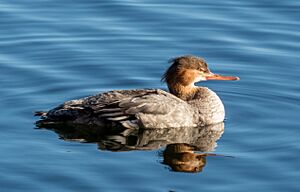Red-breasted merganser facts for kids
Quick facts for kids Red-breasted merganser |
|
|---|---|
 |
|
| Male in winter at New Jersey, United States | |
 |
|
| Female, New York, United States | |
| Conservation status | |
| Scientific classification | |
| Genus: |
Mergus
|
| Species: |
serrator
|
 |
|
| Red-breasted merganser range Breeding Resident Non-breeding Passage | |
| Synonyms | |
|
|
The red-breasted merganser (Mergus serrator) is a type of duck that lives in many parts of the Northern Hemisphere. Only the male ducks show the bright red breast that gives them their name. This color is seen when they are ready to breed.
These ducks fly very fast. They hunt for food by diving underwater from the surface. They use their special bills, which have saw-like edges, to catch slippery fish. Red-breasted mergansers migrate every year. They fly from their breeding spots on lakes and rivers to coastal areas for winter. They are the only duck in their group, Mergus, that often lives in saltwater.
Outside of the breeding season, these ducks gather in groups. These groups are usually small, but sometimes they can have up to 100 birds. The number of red-breasted mergansers around the world is steady. However, in some places, they face dangers like losing their homes.
Contents
About the Red-breasted Merganser
The red-breasted merganser is a medium-sized duck. It is about 51 to 64 centimeters (20 to 25 inches) long. Its wings can spread out 66 to 74 centimeters (26 to 29 inches) wide. These ducks usually weigh between 800 and 1350 grams (28 to 48 ounces).
It has a spiky crest on its head. Its bill is long, thin, and red. The edges of the bill are serrated, meaning they look like a saw. This helps the duck hold onto slippery fish.
What They Look Like
Male red-breasted mergansers have a dark head that shines green. Their neck is white, and their chest is a rusty color. They have a black back and white underparts.
Female ducks have a rusty-colored head and a grayish body. Young ducks look a lot like the females. However, they do not have a white collar around their neck. Their white wing patches are also smaller.
The red-breasted merganser often lives in the same areas as the common merganser. These two ducks look similar. But the red-breasted merganser is the only one that likes saltwater.
You can tell them apart by looking closely. Breeding males of both species look quite different. But females, young ducks, and non-breeding males can be harder to tell apart. The common merganser has a clearer difference between its dark head and lighter chest. It also has a light patch on its chin, which the red-breasted merganser does not have.
How They Sound
Red-breasted mergansers make different sounds. When they are trying to find a mate, the female makes a rough prrak prrak sound. The male makes a sound like a cat's meow. When flying, the female makes a harsh gruk. Most of the time, these ducks are quiet.
Red-breasted Merganser Behavior
Food and Feeding Habits
Red-breasted mergansers are expert divers. They swim underwater to catch their food. They mostly eat small fish. But they also eat aquatic insects, worms, crustaceans (like crabs), and amphibians (like frogs).
Reproduction and Life Cycle
These ducks breed on freshwater lakes and rivers. They are found across northern North America, Greenland, Europe, and parts of Asia. They build their nests on the ground close to water, in places that are hidden.
Red-breasted mergansers are migratory birds. This means they travel long distances. Many ducks that breed in the north spend their winter in warmer coastal waters further south. Outside of the breeding season, they form groups. These groups can have up to 100 ducks. The groups are smaller during spring migration than they are in autumn and winter.
Amazing Speed Record
A red-breasted merganser holds a speed record! It was the fastest duck ever recorded. It flew at a top speed of 100 miles per hour (161 kilometers per hour). This happened when it was being chased by an airplane. This speed beat the old record held by a canvasback duck, which flew at 72 miles per hour (116 kilometers per hour).
Conservation Status
The red-breasted merganser is a widespread and common bird. Because of this, the IUCN lists it as a species of least concern. This means it is not currently in danger of disappearing.
However, the number of these ducks might be going down in some areas. They face threats like losing their wetland homes. They can also be harmed by toxins like pesticides and lead. Sometimes, they get caught by accident in fishing nets. Some people who fish or farm fish have also seen these ducks as rivals. They might have tried to harm them, but we don't know how much this affects the duck's overall population.
Images for kids





